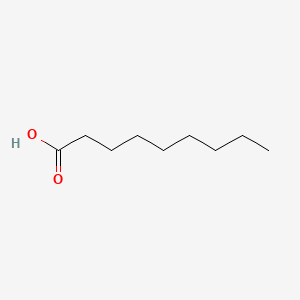| MeSH term | MeSH ID | Detail |
|---|---|---|
| Dermatitis, Contact | D003877 | 59 associated lipids |
| Facial Dermatoses | D005148 | 7 associated lipids |
| Hypersensitivity | D006967 | 22 associated lipids |
| Arteriosclerosis | D001161 | 86 associated lipids |
| Seizures | D012640 | 87 associated lipids |
| Dermatitis, Allergic Contact | D017449 | 20 associated lipids |
| Riboflavin Deficiency | D012257 | 10 associated lipids |
| Lichen Planus | D008010 | 3 associated lipids |
| Keratosis | D007642 | 9 associated lipids |
| Tick Infestations | D013984 | 4 associated lipids |
NONANOIC ACID
NONANOIC ACID is a lipid of Fatty Acyls (FA) class. Nonanoic acid is associated with abnormalities such as megalocytosis, Hypos, Renal tubular disorder, Respiratory Distress Syndrome, Adult and Little's Disease. The involved functions are known as Gene Expression, Signal Transduction, Regulation, Cell Cycle and Force. Nonanoic acid often locates in Membrane, Protoplasm, Body tissue, Extracellular and Cell membrane. The associated genes with NONANOIC ACID are cysteinylglycine, glycylsarcosine, arginine methyl ester, GLI3 gene and ADRBK1 gene. The related lipids are 1-octen-3-ol, Butyric Acids, palmitoleic acid, pentadecanoic acid and stearic acid.
Cross Reference
Introduction
To understand associated biological information of NONANOIC ACID, we collected biological information of abnormalities, associated pathways, cellular/molecular locations, biological functions, related genes/proteins, lipids and common seen animal/experimental models with organized paragraphs from literatures.
What diseases are associated with NONANOIC ACID?
NONANOIC ACID is suspected in megalocytosis, Hypos, Renal tubular disorder, Respiratory Distress Syndrome, Adult, Little's Disease and other diseases in descending order of the highest number of associated sentences.
Related references are mostly published in these journals:
- Am. J. Physiol. Heart Circ. Physiol. (1)
- Am. J. Physiol. Lung Cell Mol. Physiol. (1)
- Am. J. Physiol. Renal Physiol. (1)
- Others (1)
| Disease | Cross reference | Weighted score | Related literature |
|---|
Possible diseases from mapped MeSH terms on references
We collected disease MeSH terms mapped to the references associated with NONANOIC ACID
PubChem Associated disorders and diseases
What pathways are associated with NONANOIC ACID
There are no associated biomedical information in the current reference collection.
PubChem Biomolecular Interactions and Pathways
Link to PubChem Biomolecular Interactions and PathwaysWhat cellular locations are associated with NONANOIC ACID?
Visualization in cellular structure
Associated locations are in red color. Not associated locations are in black.
Related references are published most in these journals:
- Am. J. Physiol. Heart Circ. Physiol. (4)
- Am. J. Physiol. Lung Cell Mol. Physiol. (1)
- Am. J. Physiol., Cell Physiol. (1)
- Others (6)
| Location | Cross reference | Weighted score | Related literatures |
|---|
What functions are associated with NONANOIC ACID?
Related references are published most in these journals:
| Function | Cross reference | Weighted score | Related literatures |
|---|
What lipids are associated with NONANOIC ACID?
Related references are published most in these journals:
| Lipid concept | Cross reference | Weighted score | Related literatures |
|---|
What genes are associated with NONANOIC ACID?
Related references are published most in these journals:
- Am. J. Physiol. Heart Circ. Physiol. (2)
- Acta Trop. (1)
- Am. J. Physiol. Lung Cell Mol. Physiol. (1)
- Others (3)
| Gene | Cross reference | Weighted score | Related literatures |
|---|
What common seen animal models are associated with NONANOIC ACID?
There are no associated biomedical information in the current reference collection.
NCBI Entrez Crosslinks
All references with NONANOIC ACID
Download all related citations| Authors | Title | Published | Journal | PubMed Link |
|---|---|---|---|---|
| Höfer P et al. | Production of functionalized polyhydroxyalkanoates by genetically modified Methylobacterium extorquens strains. | 2010 | Microb. Cell Fact. | pmid:20846434 |
| Poblete-Castro I et al. | The metabolic response of P. putida KT2442 producing high levels of polyhydroxyalkanoate under single- and multiple-nutrient-limited growth: highlights from a multi-level omics approach. | 2012 | Microb. Cell Fact. | pmid:22433058 |
| Idnurm A and Heitman J | Ferrochelatase is a conserved downstream target of the blue light-sensing White collar complex in fungi. | 2010 | Microbiology (Reading, Engl.) | pmid:20488877 |
| Sarkar S et al. | Complex inhibitory effects of nitric oxide on autophagy. | 2011 | Mol. Cell | pmid:21726807 |
| Jones PM et al. | Effects of odd-numbered medium-chain fatty acids on the accumulation of long-chain 3-hydroxy-fatty acids in long-chain L-3-hydroxyacyl CoA dehydrogenase and mitochondrial trifunctional protein deficient skin fibroblasts. | 2004 | Mol. Genet. Metab. | pmid:14741189 |
| Sehba FA et al. | Metamorphosis of subarachnoid hemorrhage research: from delayed vasospasm to early brain injury. | 2011 | Mol. Neurobiol. | pmid:21161614 |
| Meij JT et al. | Differential mechanisms of nitric oxide- and peroxynitrite-induced cell death. | 2004 | Mol. Pharmacol. | pmid:15258257 |
| Griffiths C et al. | A new and simple method for delivering clamped nitric oxide concentrations in the physiological range: application to activation of guanylyl cyclase-coupled nitric oxide receptors. | 2003 | Mol. Pharmacol. | pmid:14645665 |
| Garthwaite G et al. | Soluble guanylyl cyclase activator YC-1 protects white matter axons from nitric oxide toxicity and metabolic stress, probably through Na(+) channel inhibition. | 2002 | Mol. Pharmacol. | pmid:11752210 |
| Jang YW et al. | Nonanoic Acid, an Antifungal Compound from Hibiscus syriacus Ggoma. | 2012 | Mycobiology | pmid:22870060 |
